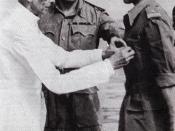GEK1035
Nations and Nationalisms in South Asia
Term Paper (Topic 6)
The Build-Up to the Emergence of Bangladesh
Harphoon
�
The 'two nation theory' which was purposed by Mahomed Ali Jinnah states that 'the Hindus and Muslims belong to two different religious philosophies, social customs, and literature' so that if these two 'nations' were to stick together, i.e. were the partition not to happen, the fact that one nation is a numerical minority and the other is a numerical majority would 'lead to growing discontent and final destruction of any fabric that may be so built up for the united government of such a state'.� Indeed, 24 years after the partition, in 1971, within the Pakistan the Muslim nation, the conflicts between a numerical minority, namely the West Pakistanis, and Bengalis as a numerical majority did tear the religion bound that was supposed to hold the two wings together.
The tragedy stayed on the headlines from March 1971 to December that year, however, as this essay will demonstrate, its main causes had been laid down long before. Basically there are three groups of factors, namely political and economic disparity, cultural differences and the rise of Bengali regionalism vis-Ã -vis the federal center. The interaction and relative importance of these factors will also be examined.
It should be noted that Pakistan as a state started with great handicaps. In terms of cultural affinity, the two wings shared few things in common, except the religion. Unlike India which inherited the political establishment of the British Raj, Pakistan had to build its state structure from ground zero. Although Jinnah's declared intention was that Pakistan would 'maintain cordial and friendly relations with our immediate neighbor' when he took oath as the first governor-general of Pakistan�, the relation between these two states deteriorated dramatically to...



The Build-Up to the Emergence of Bangladesh
This essay is remarkable. The writing is generally very solid, and the whole product bespeaks a remarkable understanding of a vast range of subtle material. This is the sort of essay that is a genuine university level product. While citations to the specific points made in the essay would be nice, overall this essay is already very, very solid.
Bravo!
0 out of 0 people found this comment useful.